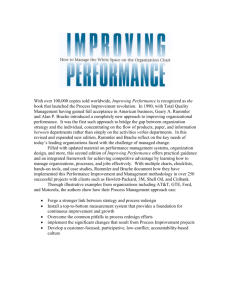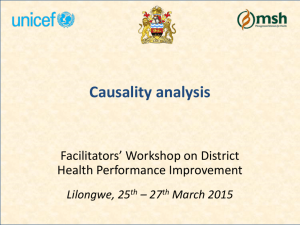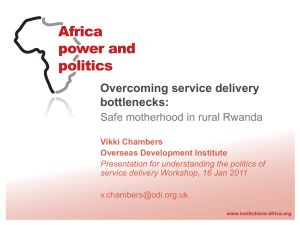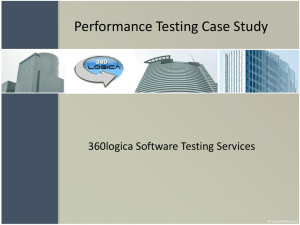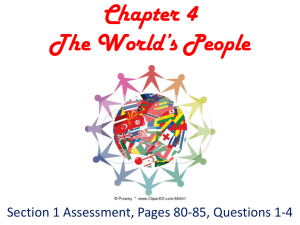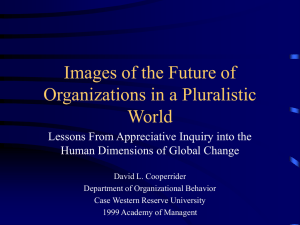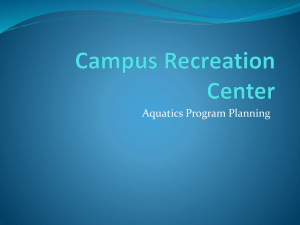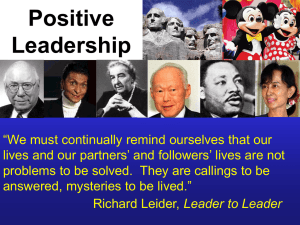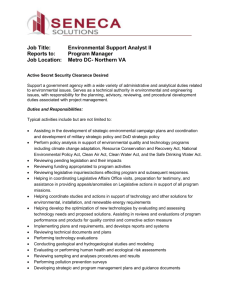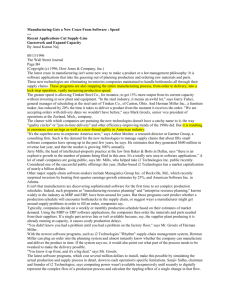How to review your processes
advertisement
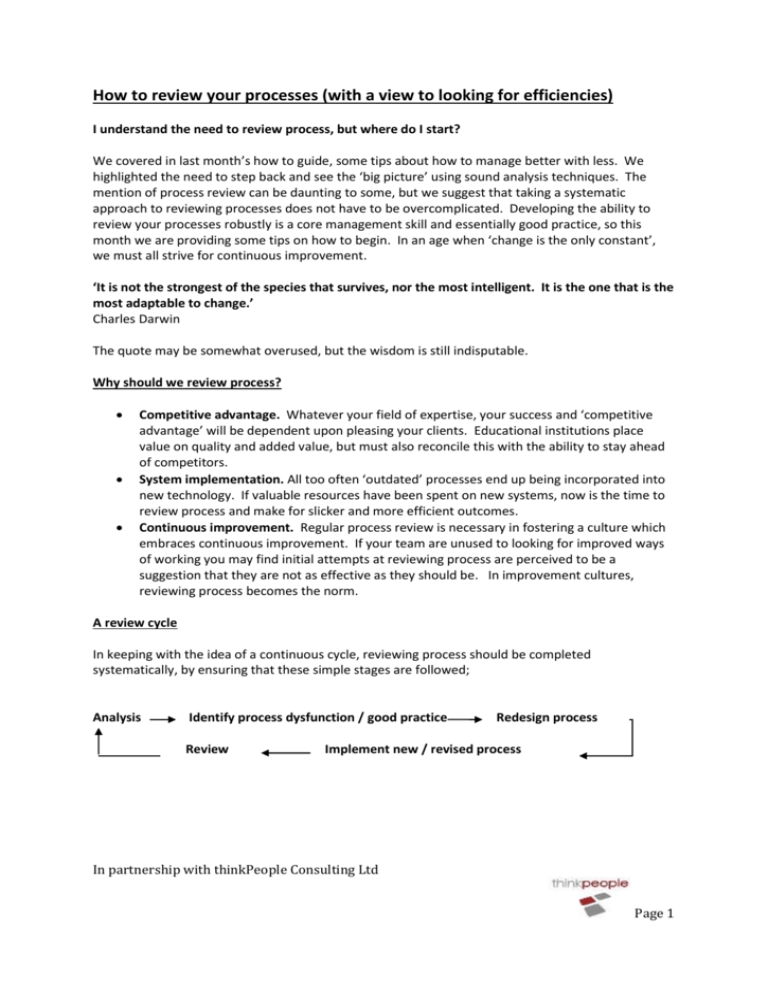
How to review your processes (with a view to looking for efficiencies) I understand the need to review process, but where do I start? We covered in last month’s how to guide, some tips about how to manage better with less. We highlighted the need to step back and see the ‘big picture’ using sound analysis techniques. The mention of process review can be daunting to some, but we suggest that taking a systematic approach to reviewing processes does not have to be overcomplicated. Developing the ability to review your processes robustly is a core management skill and essentially good practice, so this month we are providing some tips on how to begin. In an age when ‘change is the only constant’, we must all strive for continuous improvement. ‘It is not the strongest of the species that survives, nor the most intelligent. It is the one that is the most adaptable to change.’ Charles Darwin The quote may be somewhat overused, but the wisdom is still indisputable. Why should we review process? Competitive advantage. Whatever your field of expertise, your success and ‘competitive advantage’ will be dependent upon pleasing your clients. Educational institutions place value on quality and added value, but must also reconcile this with the ability to stay ahead of competitors. System implementation. All too often ‘outdated’ processes end up being incorporated into new technology. If valuable resources have been spent on new systems, now is the time to review process and make for slicker and more efficient outcomes. Continuous improvement. Regular process review is necessary in fostering a culture which embraces continuous improvement. If your team are unused to looking for improved ways of working you may find initial attempts at reviewing process are perceived to be a suggestion that they are not as effective as they should be. In improvement cultures, reviewing process becomes the norm. A review cycle In keeping with the idea of a continuous cycle, reviewing process should be completed systematically, by ensuring that these simple stages are followed; Analysis Identify process dysfunction / good practice Review Redesign process Implement new / revised process In partnership with thinkPeople Consulting Ltd Page 1 What should be analysed? Rather than focus on the specifics of any job or sequence of jobs, it is important to consider the outcome or end result. For example, the end goal of teaching is not to repeat facts or mark papers, but to impart knowledge which is retained by the student. ‘Process is a related group of tasks that together create a result of value to the customer.’ Moriarty & Thompson The simplest model of process is described in three components; Input Output TRANSFORMATION As mentioned earlier, process review need not be complicated. The key however, is to be clear about what your end goal is or desired output. If we are focusing on creating efficiency, then we suggest applying our ROSS principle in testing the efficiency of any process; Right – Do it right Once – Do it once Speed – Do it quickly Simplicity – Keep it simple Start with selecting a project team. A crucial part of engaging stakeholders as discussed last month, will be to get the people that work for you and with you on board from a very early stage. The benefits of engaging a project team to review process are associated with their knowledge and experience of current processes and their ability to influence the success or failure of changes to current practice. It is prudent to choose a mix of participants in the project team. All involved should know current process well, but depending on the specific process to be reviewed, you may need to include team members with specialist knowledge or skills. Think about including a mix of problem solving, creativity and methodical personality types to give a healthy balance to the project team. Engaging the team through meaningful two way communication and giving them ownership to review what they do, will not only increase your chances of success but will motivate your team to continue to find improvements, well past the initial review. Analysis and problem solving techniques With your team on board, it is useful to develop problem solving and analysis techniques to use with the group. A brief description of some well known techniques is described below. You may wish to contact your HR provider about the possibility of problem solving workshops. In partnership with thinkPeople Consulting Ltd Page 2 1.Flow charts Flow charts are user friendly diagrams which depict the various steps involved in a process. They are a useful tool in visually communicating all the steps that fit together in a current process. By mapping out the process as a team this facilitates joint understanding and allows each step to be assessed for efficiency. Generally oblong shapes are used to mark the beginning or end of a process, rectangles are used to show actions and diamonds are used to show decision points. Arrows are used when a process may involve a number of different actions depending on what happens at each stage. Practice by mapping a simple process such as making a cup of coffee. 2. Swim lane diagrams Introduced in the 90’s by Rummler and Brache in their book ‘Improving Processes’. This method of diagramming is particularly useful when a number of different departments or functions must interact to complete a specific process. The diagram is set out linearly in what appear to be ‘swim lanes’ and shows the interconnections between processes, departments and teams. Lines and arrows between tasks represent the flow of information, goods or work-in-progress, and also represent changes in responsibility. As with simple flow charts, swim lane diagrams once completed allow the project team to analyse the process. Swim lanes are particularly useful in picking up unnecessary duplication, over complication and activity which slows down the output. 3. Story boarding The use of storyboarding began in the film industry in order to map out the scenes to be included from beginning to end. Storyboarding has now become a potentially energising and creative problem solving technique, using ‘pictures’ to describe end to end process. Story boards are loose depictions of process and their creation often encourages creativity in considering efficiencies at each stage. Storyboards can be more easily understood than when process is put into diagrammatic form and are often used in brainstorming sessions. 4. Unblocking bottlenecks Bottlenecks occur at the point in any process where the input comes in faster than the next stage in the process can process . Short term bottlenecks can occur when expertise in a process step is limited to one person. When this person is absent or on leave, a bottleneck occurs. Longer term bottlenecks tend to reoccur regularly and reflect either inefficiency or a process which is under resourced. When bottlenecks are identified it is useful to use the ‘why’ technique. Children learn vast amounts by repeating the question why(much to the annoyance of their parents!) This technique has been widely adopted as an effective drill down technique to find root causes. Starting with the problem, ask why repeatedly, e.g. Why are the month end accounts not ready? Because the accountant is still working on them. Why is he still working on them? Because he only just received month end figures. Why did he just receive the figures? Because they are produced be one administrator who is off sick. In this case, the simple solution would be to ensure others are trained to produce month end. When bottlenecks occur, the solution will be either to decrease the input into the bottleneck step or increase the efficiency of the step. This might mean reallocating tasks or individuals. In partnership with thinkPeople Consulting Ltd Page 3 5. Appreciative enquiry Pioneered by David Cooperrider in the 80’s, appreciative enquiry turns traditional problem solving on its head by focusing on what is good rather than ‘fixing’ the problems. It is essentially an analysis technique which builds on what works well. Reviewing processes should not be about ditching the good things in the mix or losing valuable experience and knowledge; ‘Do be careful that you don't throw the baby out with the bath water’ Young This technique follows five phases and is usually highly collaborative; 1. Define – Focusing on the desire outcome, e.g. building a more efficient and effective grant proposal process. 2. Discover – Identify what has and is working well about the current process. 3. Dream – Create a vision of your ideal outcome, describe what that looks like. Can be done in large groups. 4. Design – Drill down the systems, processes and strategies that will enable the vision to become reality. 5. Deliver -Implementation of newly designed process and interactions, this should be managed as a change project and should be closely managed. Implementation and review Arguably the most difficult part of process review is successful implementation. However minor the change, it is important to apply the principles of successful change management in order to increase the likelihood of successful implementation. In particular recognise the natural resistance to change which occurs. ‘People are very open-minded about new things - as long as they're exactly like the old ones.’ Charles Kettering - Inventor Provide honest open information about the need to change process Allow people to express their views and have their questions and fears addressed Consider how influential individuals in the process might be persuaded to help rather than hinder the new way of working, this might be as simple as giving them an important position within the project team. Finally, it will be important to complete the cycle by building in a robust review, assessing the redesigned process. During the review, refer back to the original end goal and the impact on the client or end user. References Young, J. P. (1979) Moriarty T. & Thomson V. (1996) Brache, A.P. & Rummler, G.A.,(1990). Cooperrider, D & Srivastva, S,. (1987) Art of Learning to Manage Business Analysis Techniques Improving Performance Appreciative Inquiry in Organizational Life In partnership with thinkPeople Consulting Ltd Page 4
